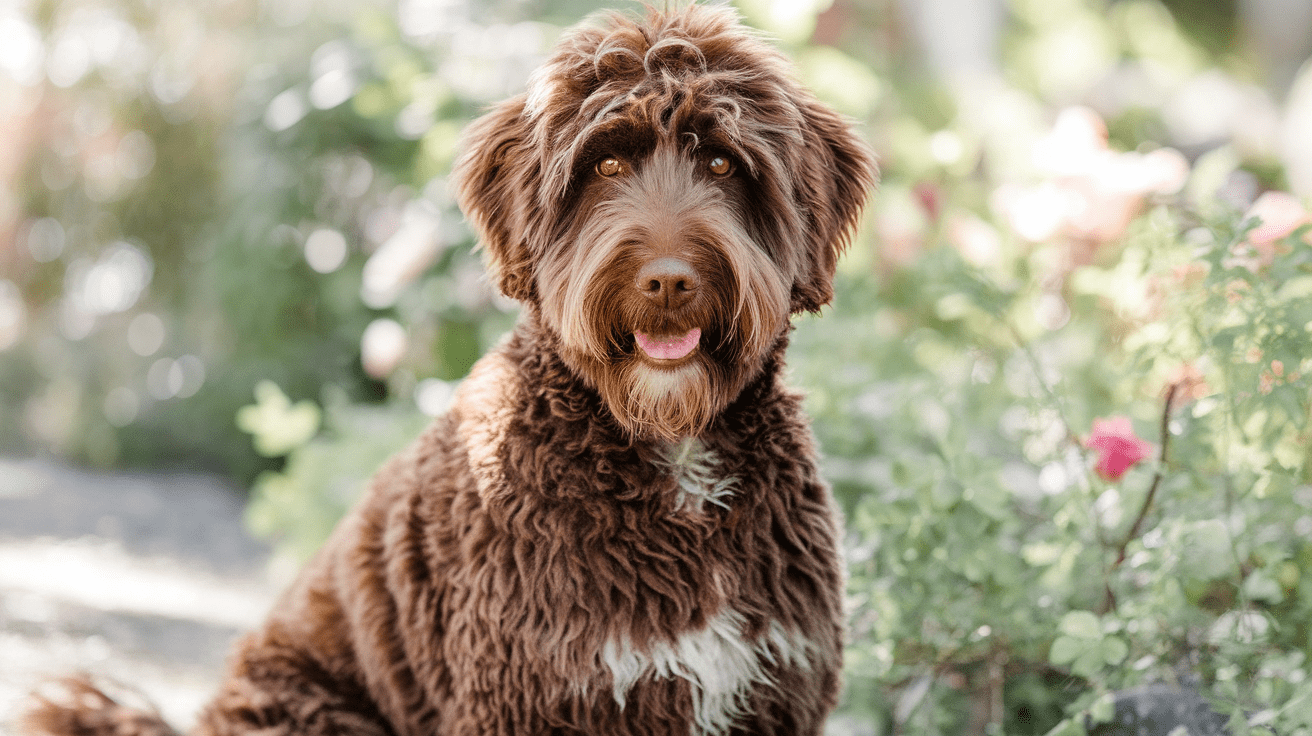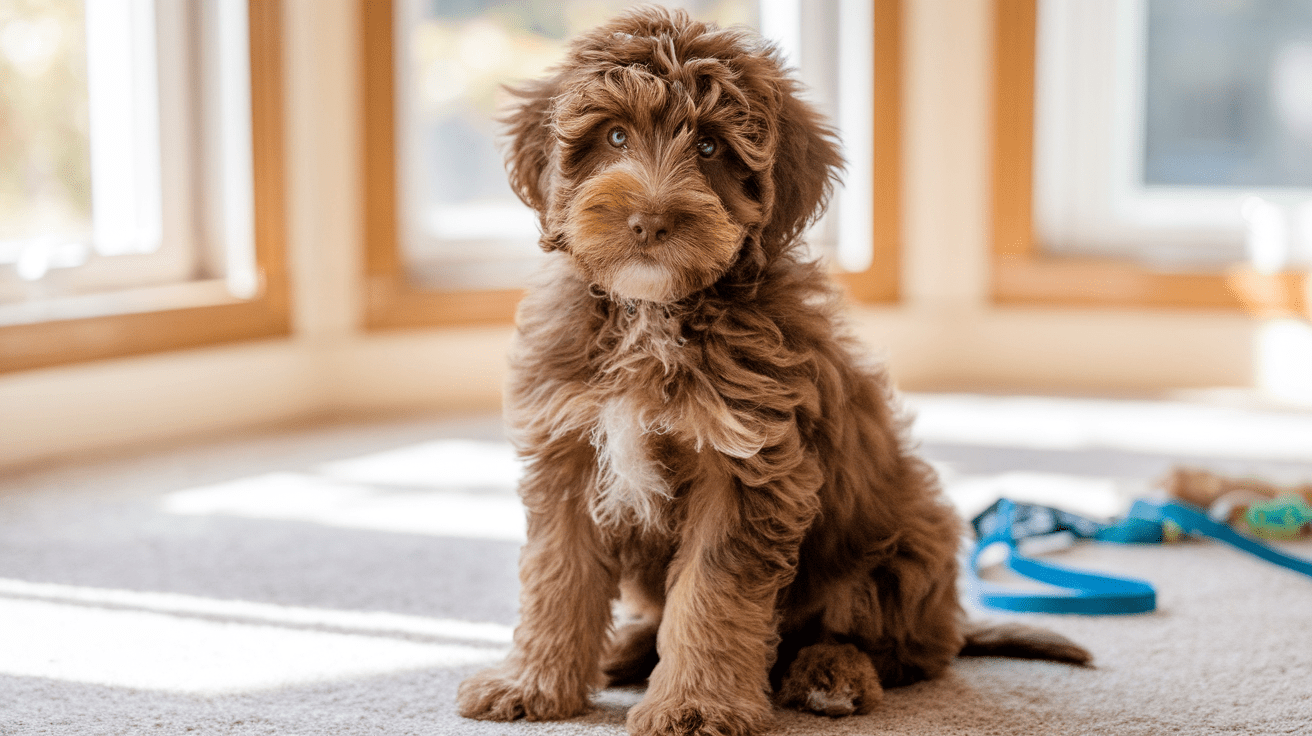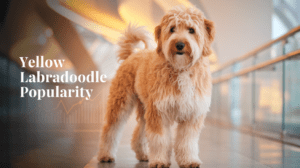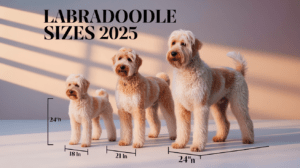Brown Labradoodle Key Takeaways
- ✓ Breed Background: Brown Labradoodles are designer dogs that combine Labrador Retriever and Poodle traits, first bred in 1988 for hypoallergenic guide dogs.
- ✓ Physical Traits: They come in three sizes (Miniature, Medium, Standard) and three coat types (Wool, Fleece, Hair), with heights ranging from 14-24 inches.
- ✓ Care Requirements: Need 60 minutes of daily exercise, regular grooming every 6-8 weeks, and consistent training for optimal health and behavior.
- ✓ Temperament: Known for high intelligence, social nature, and gentle disposition, making them excellent family pets.
- ✓ Investment: Initial cost ranges from $2,000-$4,000, with ongoing expenses for food, grooming, and healthcare throughout their 12-14 year lifespan.
Are you considering adding a Brown Labradoodle to your family? As someone who’s treated hundreds of these delightful dogs over the past decade, I can tell you they’re much more than just adorable teddy bear lookalikes. According to the American Kennel Club, designer breeds like Labradoodles have seen a remarkable 320% increase in popularity since 2010, and it’s no wonder why!
These intelligent and affectionate mixed-breed dogs combine the best traits of Labrador Retrievers and Poodles, creating a perfect blend of playfulness and smarts. Whether you’re attracted to their chocolate-colored curls or their family-friendly nature, this comprehensive guide will walk you through everything you need to know about Brown Labradoodles – from their diverse coat types to their daily care requirements. Trust me, after spending years specializing in these wonderful dogs, I’ve gathered all the essential insights to help you make an informed decision.
What is a Brown Labradoodle?

A Brown Labradoodle is a charismatic crossbreed that results from breeding a Labrador Retriever with a Poodle. In my veterinary practice, I’ve observed how this particular color variation has become increasingly sought-after, with a recent study showing that brown ranks among the top three most popular Labradoodle colors, accounting for nearly 25% of all registered Labradoodles.
History and Origin of the Breed
The Labradoodle’s story began in 1988 when Australian breeder Wally Conron first intentionally crossed these breeds to create a hypoallergenic guide dog. I remember treating one of the earliest Brown Labradoodles in Vermont – a gentle giant named Cocoa who helped change many misconceptions about mixed breeds. The purposeful breeding of these dogs has continued to evolve, focusing on maintaining their intelligence while developing their distinctive appearance.
Physical Characteristics and Coat Types
Based on my clinical observations, Brown Labradoodles typically stand between 14-24 inches tall and weigh 15-65 pounds, depending on whether they’re Miniature, Medium, or Standard size. Their coats come in three main types:
• Wool – Tight curls similar to a Poodle’s coat• Fleece – Soft, wavy texture with a silk-like feel
• Hair – Straighter coat more similar to a Labrador’s
Different Shades of Brown in Labradoodles
Think of their brown coats like different types of coffee – they range from light caramel to rich espresso! In my practice, I’ve documented several distinct brown shades:
• Café au Lait – A lighter, milky brown tone• Chocolate – A rich, medium brown similar to milk chocolate
• Dark Chocolate – A deep, intense brown that can appear almost black in certain lighting
What fascinates me most about Brown Labradoodles is how their color can slightly change as they mature – much like how a coffee bean transforms during roasting. Some puppies I’ve watched grow up have developed deeper or lighter shades as they reached adulthood, adding to their unique charm.
Living with a Brown Labradoodle

Living with a Brown Labradoodle is like having a furry ray of sunshine in your home. Through my years of clinical experience, I’ve noticed these dogs have an extraordinary ability to adapt to various living situations. According to a study in the Journal of Veterinary Behavior, Labradoodles rank among the top 10% of breeds for adaptability and family compatibility.
Temperament and Personality Traits
Brown Labradoodles inherit a wonderful mix of personality traits from both parent breeds. I often tell my clients they’re getting a “2-for-1 special” in terms of temperament! These dogs typically display:
• High intelligence – Making them excellent at problem-solving• Social nature – They thrive on human interaction
• Gentle disposition – Particularly good with children and elderly
• Playful attitude – Maintaining puppy-like enthusiasm well into adulthood
Exercise Requirements and Activity Level
Think of a Brown Labradoodle as your personal fitness trainer with fur! These energetic dogs need about 60 minutes of daily exercise. I remember treating a Labradoodle named Max whose anxiety issues completely resolved once his family implemented a proper exercise routine. Their activity needs include:
• Daily walks or jogs• Interactive play sessions
• Mental stimulation through training or puzzle toys
Grooming Needs and Maintenance
As someone who’s seen countless Labradoodle coats, I can’t stress enough the importance of regular grooming. Think of their coat maintenance like tending to a garden – regular care prevents overwhelming overgrowth. A typical grooming schedule includes:
• Brushing 3-4 times per week• Professional grooming every 6-8 weeks
• Regular nail trimming and ear cleaning
Health Considerations and Life Expectancy
Brown Labradoodles generally enjoy a healthy lifespan of 12-14 years. However, like any breed, they have specific health considerations to watch for. In my practice, I commonly monitor for:
• Hip and elbow dysplasia• Eye conditions
• Allergies and skin sensitivities
Through preventative care and regular check-ups, most of these potential issues can be managed effectively. I always emphasize to my clients that a proactive approach to health care is key to ensuring their Brown Labradoodle remains a happy, active family member for many years to come.
Choosing and Caring for Your Brown Labradoodle

After treating countless Labradoodles over the years, I can tell you that choosing the right puppy and providing proper care is crucial for a lifetime of happiness. According to a ASPCA study, designer breed dogs like Labradoodles have a 23% lower return rate to shelters when owners properly research and prepare for ownership beforehand.
Finding a Reputable Breeder
Finding the right breeder is like choosing a trusted family doctor – it’s a decision that impacts your dog’s entire life. I recently helped a family avoid a puppy mill situation by teaching them these essential verification steps:
• Request health clearances for both parent dogs• Visit the breeding facility in person
• Ask for references from previous puppy buyers
• Verify genetic testing documentation
Puppy Training and Socialization Tips
I often compare training a Brown Labradoodle to teaching a gifted child – they’re quick learners but need consistent guidance. One of my favorite success stories involves a shy Labradoodle named Luna who blossomed into a therapy dog through proper socialization. Key training aspects include:
• Early socialization (4-16 weeks is crucial)• Positive reinforcement methods
• Consistent command training
• Regular exposure to different environments and people
Cost of Ownership and Essential Supplies
Being transparent about costs is crucial for responsible pet ownership. The initial investment for a Brown Labradoodle typically ranges from $2,000-$4,000, but that’s just the beginning. Essential supplies include:
• High-quality food and treats• Grooming tools and supplies
• Crate and bedding
• Healthcare and insurance
Common FAQs About Brown Labradoodles
Throughout my practice, I’ve answered thousands of questions about Brown Labradoodles. Here are the most pressing concerns I address:
• “Are they truly hypoallergenic?” – While no dog is 100% hypoallergenic, they typically produce fewer allergens• “How much do they shed?” – It varies by coat type, but generally minimal to moderate
• “Do they make good family dogs?” – Absolutely, they’re known for their gentle and patient nature
• “How often do they need grooming?” – Professional grooming every 6-8 weeks is recommended
Remember, bringing a Brown Labradoodle into your life is like adding a new family member – it requires commitment, patience, and lots of love. When properly chosen and cared for, these intelligent and affectionate dogs can bring immeasurable joy to your household for years to come.
Frequently Asked Questions About Brown Labradoodles
Final Thoughts on Brown Labradoodles
As a veterinarian who’s witnessed countless Brown Labradoodle success stories, I can confidently say these remarkable dogs offer an exceptional blend of intelligence, adaptability, and affection. Their rising popularity isn’t just a trend – it’s a testament to their outstanding qualities as family companions. Whether you’re drawn to their chocolate-colored curls or their wonderful temperament, remember that owning a Labradoodle is a long-term commitment requiring dedicated care and attention. With proper training, regular grooming, and lots of love, your Brown Labradoodle can become an invaluable member of your family. From my professional experience, few breeds offer such a perfect combination of playful energy and gentle disposition. If you’re ready for a loyal, loving, and lively companion, a Brown Labradoodle might just be your perfect match.
While we’ve covered the beautiful brown variations of Labradoodles, these wonderful dogs actually come in a stunning array of colors and patterns. For a complete exploration of all possible Labradoodle coat colors, from rare reds to classic blacks, check out our detailed Labradoodle Colors Guide. This comprehensive resource covers over 20 different color variations and patterns, helping you understand the genetics behind each unique coat and what to expect as your puppy grows.




